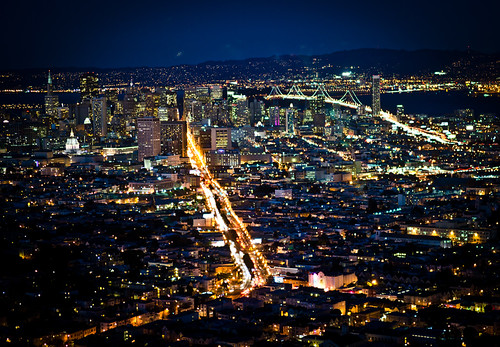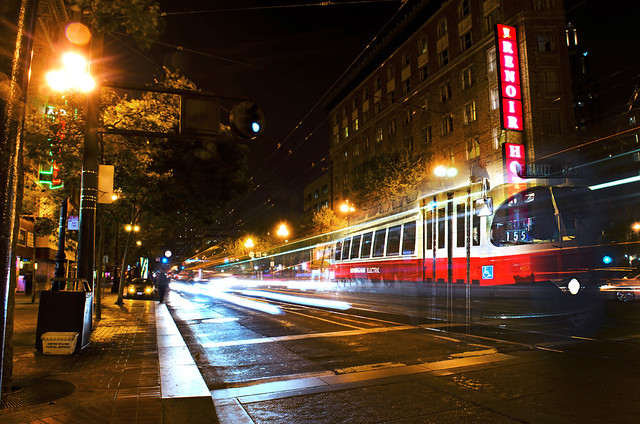It is where the Giants celebrated their World Series win. It spreads from Twin Peaks to the Embarcadero. Trolleys, streetcars, and Muni buses journey above it while the Muni Metro and BART travel below it. It’s consistently home to pedestrians, protestors, vendors, tourists, commuters, and cyclists, and it’s definitely no stranger to bumper-to-bumper traffic. All San Francisco locals know Market Street. Some flock to it, others avoid it. Today there is talk of new developments to revitalize Market Street, including an initiative to make Market completely car-free. Would it be better? Worse? How would things be different?

“As someone who works over in the Financial District, and travels through Market almost daily, I feel like traffic surrounding Market would be congested,” says San Francisco native Issac Dana. “It wouldn’t do much for pedestrians, as the street itself is still extremely busy and crowded.”
A car-free Market Street has been an ongoing debate in the city because of its ability to improve public transportation and provide a more comfortable environment for bikers and pedestrians. Mayoral Candidate and Board of Supervisors President David Chiu is at the forefront of the discussion and has called for the San Francisco Municipal Transportation Agency and other departments to implement further diversions of private automobiles on Market Street.
“A viable vision for the future of Market Street is of a world-class avenue drawing its success from the huge numbers of people it attracts through transit and taxis, and on foot and bicycle, and no private automobiles other than delivery vehicles,” explains Supervisor David Chiu in his statement to the press. “We need to act now to make this vision a reality and to speed up transit while improving the comfort of people walking and biking, and supporting the local commercial and cultural function of the street.”

There are more than twenty transit lines that run through Market Street that constitute about 125,000 boardings a day, and, according to the SFMTA’s Bicycle Count Report, the location with the most observed bicyclists in 2010 was 11th Street at Market Street totaling in 818 bicyclists. The SFMTA’s Collision Report records that 531 injury collisions occurred in 2009 involving bicyclists.
“The San Francisco Bicycle Coalition is actively involved in the Market Street trials and committed to helping make Market Street the safest and most enjoyable street for people who walk and those who ride bikes,” said Kristin Smith, Communications Director for the San Francisco Bicycle Coalition.
“I understand that Market is a main thoroughfare, and that there are no other direct routes through that part of the city, but with a few other traffic changes I think it would greatly improve Market Street,” said San Francisco resident Michelle Reyes. “Creating a space that is safer for cyclists and pedestrians would greatly improve Market Street, particularly the mid-market area. There is already a revitalization effort for Mid-Market, and to remove vehicular traffic would further assist that effort.”
Both Chiu and the San Francisco Planning and Urban Research Association (SPUR) have stressed that the majority of drivers on Market Street tend to be tourists. According to research from the San Francisco Travel Association, there were about 15. 9 million people that visited San Francisco in 2010, and, collectively spent, about $8.34 billion. It’s no secret that tourism brings in tremendous revenue to the city, but endorsers of car-free Market Street have yet to explain how tourism would be affected when driving would be restricted in a popular tourist area.
“I think it would be a very bad thing to restrict cars on Market,” explained Bay Area native Arianne Torres, who often drives downtown. “The city is already bad enough to drive in with all the one way streets and no left turns. It would definitely create even more traffic than there already is.”
“But, because Market Street (luckily!) is not dominated by private cars now, removing the relatively small number (mostly lost tourists and visitors–no one in their right mind drives on Market) would not have the kind of transformative impact on the street as a place that it might have on a more conventional American street,” explained Benjamin Grant, Public Realm and Urban Design Program Manager for SPUR.
Currently, a specific plan has yet to be announced, but since many of the Mayoral candidates, including David Chiu, John Avalos, Dennis Herrera, and Ed Lee support, the initiative, a car-free Market Street could be in the city’s immediate future.

